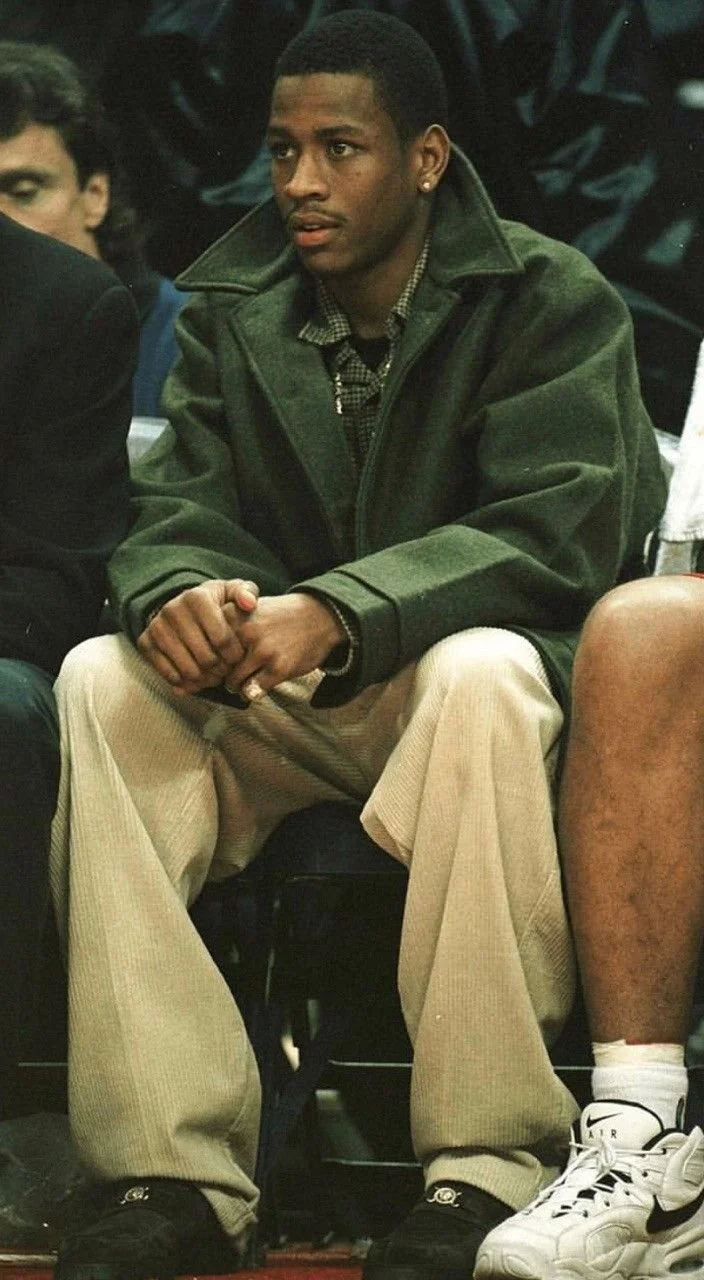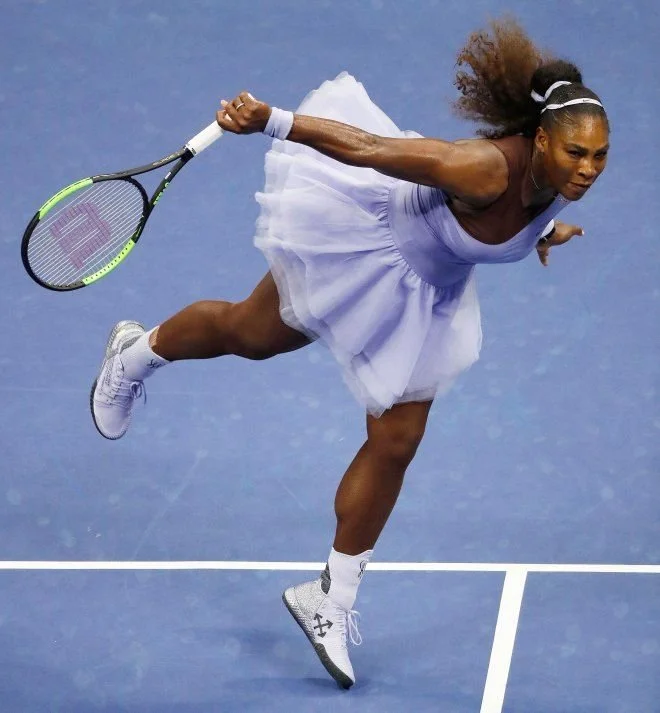Iverson, Williams, Ali: The Walk That Made the World Watch
They didn’t just play. They entered. Walked in like they owned the moment, because in many ways, they did. Before the game clock started, before racquets clashed or sneakers squeaked, there was the walk. And we watched.
76ers v Bullets - 22 Nov 1996: Doug Pensinger/ALLSPORT
Setting The Scene
Pre-Instagram hashtags, Muhammad Ali’s silk robes and sharp suits made statements louder than words. Before the NBA’s viral tunnel fits, there was Allen Iverson in throwback jerseys. And by the time Serena swung in head-to-toe Off-White by Virgil Abloh, Black athletes began redefining what style meant and looked like. Black athletes were forced to pave the way for what we know now as the future of dominance in the industry. They were the eras where style, sport, and self-ownership collided in ways that still ripple through culture today.
Each walk was a statement. Not just of style, but of identity. These were not passive participants in culture; they were architects of style.
Allen Iverson: From Newport News to the League’s Front Door
Long before the NBA and endorsement deals, Allen Iverson was a kid from Hampton, Virginia. Iverson was a multisport athlete who quickly became a star at Bethel High School. Raised by a single mother, AI’s journey to fame was more grit than glamor. Although he dominated the court, many parts of his life were out of his control. Iverson survived incarceration at 17, where he emerged from a system meant to swallow him, and later transformed Georgetown University's court into his oyster.
When he reached the NBA, he brought every part of where he came from with him. His braids were nothing short of a homage to his home and identity. His oversized fits and his resistance to assimilation is what ultimately positioned him as a trailblazer.
Allen Iverson mended the bridge for future athletes to show up fully themselves. Iverson was the answer.
June 6, 2001. Allen Iverson scored 48 points in Game 1. Wearing the Reebok Answer IV, he dominated against the Lakers in the 2001 NBA Finals.
When Reebok saw Iverson, they didn’t just see a bold player—they saw a story. They saw a kid who wasn’t supposed to make it but did. In 2001, the same year he carried Philly to the Finals and shook Tyronn Lue out of his sneakers, Iverson secured a refined deal with Reebok that gave cash for something bigger: security. A guaranteed $800K every year for life, and a $32 million trust waiting for him once he turned 55. This was the lifeline Iverson needed.
Through it all, Reebok stood by him. Even when the world turned its back. Even when AI’s own fortune crumbled, when he became a victim of his lavish lifestyle, that trust fund was his safety net. By staying authentic to himself, Iverson accomplished dreams most wouldn’t dare to believe in. He never bent to fit the mold. And now, over two decades later, that same kid from Hampton isn’t just an icon—he’s the vice president of Reebok Basketball in partnership with Shaq, shaping the future of the game together. Iverson’s journey with Reebok is a testament to resilience, loyalty, and a legacy that can’t be rewritten.
Serena Williams: From Compton Courts to Global Couture
Before Serena wore Off-White on Arthur Ashe, she was hitting balls with her sister Venus on cracked courts in Compton, California, a city known more for hip-hop and hardship than country clubs and tennis culture. Under the guidance of her father Richard, her game was forged in a place where tennis was unfamiliar.
Serena Williams wears one of the tutus during the 2018 U.S. Open. JASON SZENES/EPA-EFE/Shutterstock
Where most players conformed to all-white tradition, Serena stepped outside the lines. From beaded braids to Black Panther-inspired catsuits that echoed resistance, she didn’t just play the game, she redefined who it was for. On a global stage that often tried to mute Black expression, she made her presence uniquely bold, turning every outfit into a statement of pride, power, and protest.
Her 2018 collaboration with Virgil Abloh and Off-White was a full-circle moment: Black streetwear, high fashion, and athletic grace in perfect harmony. Off-White was more a cultural shift than it was a brand. Founded by Abloh, the first Black artistic director at Louis Vuitton, it blurred the lines between luxury and the streets, championing a vision where skate culture, hip-hop, and high fashion shared the same runway. For Serena, already a symbol of boundary-breaking, partnering with Virgil wasn’t just about style. It was a statement. A dialogue between two Black icons who redefined their industries, on their own terms. The collaboration was layered: a tutu on a tennis court, sneakers with a swoosh dipped in meaning, and an unspoken message that Black creativity didn’t just belong, it led.
Serena redefined what dominance looked like: powerful, unapologetic, and entirely her own. Now athletes like Coco Gauff and Naomi Osaka aren’t just winning titles they’re owning their narratives. Serena walked so the next generation could float between the runway and the baseline without ever changing shoes. She didn’t just open the door, she changed the walk.
Muhammad Ali: Louisville’s Loudest Legend
Cassius Clay from Louisville, also known as Muhammad Ali, was more than just a boxer; he was a blueprint for the future. The silk robes, the tailored suits, and the dashikis transcended beyond fashion statements as they were declarations of his identity.
Gordon Parks, Untitled, London, England, 1966Courtesy of The Gordon Parks Foundation, New York and Alison Jacques Gallery, London © The Gordon Parks Foundation
Long before the flash caught him entering arenas draped in silk, Ali was already writing his story. Raised in the Jim Crow South, Ali’s journey was everything but silent. It was about being seen. Ali didn’t simply walk into a ring, he was stepping into a generational legacy. His presence, from his robes to his fists, was a reminder: this was more than sport, it was resistance.
Ali redefined and re-owned professional and sports attire. He made his clothes fight as hard as he did. His robes were armor, wrapped in pride and power. Off the clock, Ali kept that same energy. Sharp suits, bold ties, and a walk that said, I belong here. Muhammad Ali never played a part when he told the world who he was.
When Ali wore dashikis, kufis, and prayer caps, it was his faith and heritage stitched into every move. He was a Black Muslim man, and he made sure the world saw it, whether they respected him or not. At a time when the system tried to silence him, Ali’s style spoke louder. His clothes weren’t only statements, as much as they were a refusal to assimilate, but a testament to a life lived on his own terms.
The Walk Forward
The walk forward has always been laced with style. Muhammad Ali made his identity his uniform, clean lines, and bold words working in tandem. Allen Iverson shattered the NBA dress code with cornrows and oversized fits, bringing hip-hop’s ethos courtside and resisting assimilation. Serena carried that torch onto center court, pairing power with tutus, catsuits, and custom Off-White. Their fashion wasn’t only flair; it was language and rebellion.
This is what The Walk Thru is about. Not just fashion, but the freedom behind it. The past in every fit. The future in every frame. Because we’re not just watching the game. We’re walking in legacy.




